This one is at the request of Robert Beckett. You can see the database entry for this property here.
20 Queen Square was built c.1865 by Daniel McNicol. It was originally 9 Queen Square, but the street was renumbered around 1931.
Thomas McLaren
Thomas McLaren (1832-1908) was born in Bannockburn, Stirlingshire. In 1856 he married Jessie Bryce Paterson from Greenock, and they lived in Edinburgh initially. They had a large family of five sons and two daughters. He and his family were resident at 9 Queen Square from 1866 to at least 1874. Jessie died in 1874 and Thomas later remarried. He was living on Victoria Road in 1881, and died in Glasgow in 1908.
Thomas was a merchant and agent, variously for oil, candles, rice and tea. In 1871 he was an agent for Wm Taylor & Co of Leith, manufacturers of composite, paraffin and sperm candles, and Irvin, Son & Jones, rice and rice flour millers. He was a member of The Brethren and on retiring undertook missionary work abroad in the early 20th century.

Thomas McLaren and family. Credit: Catie Corbett, Ancestry.co.uk
The Brethren’s Archive includes this biography of the man, his strong religious beliefs and overseas adventures.
Chief Men Among the Brethren Biography (1st Edition)
THE descendant of sturdy Highland ancestors, THOMAS McLAREN was born in the historic village of Bannockburn on the 7th February, 1832. From his earliest moments he was surrounded by all the advantages of a pious home. When but a lad he entered the service of the Post Office in Alloa, with which a bookseller’s business was connected. From there he went to the office of the Clackmannan Colliery, and was next called to take charge of the dye-works of Messrs. Ramsay in Greenock, where he began his duties in the year 1850, being then eighteen years of age. He remained in the then famous sugar town for some four years, and formed lifelong Christian friendships, and actively engaged in evangelical work. Here also it was that he made the acquaintance of a high spirited, warm-hearted Christian worker, Miss Janet Bryce Paterson, to whom he was eventually joined in marriage on 9th April, 1856. Their first home was in Edinburgh, whence he had removed to fill a more responsible position. His energy and business connections soon necessitated his removing to Glasgow, taking up his residence there in the year 1859. For forty-nine years in the great commercial capital of Scotland he diligently and earnestly sought to serve the Lord.
Shortly after taking up residence in Glasgow, he accepted office in the United Presbyterian Church to which he belonged. His secret devotions were of a very searching and thorough nature, as his private papers now reveal. By prayer, and the reading and pondering over the Word, he quickly outgrew the formalism and restrictions of his religious surroundings. In 1861 he was preaching the Gospel publicly, evidently in the midst of opposition, as the following anonymous letter, received by him on 1st August, 1861, indicates: ” Dear Brother, — When you were preaching on Sabbath night I felt as if I could rush, through the crowd and tell you how precious to my soul were the truths you were declaring. Go on with your works of faith and labours of love, and God will give you souls for your hire. Let the world cry ‘enthusiast.’ He who is for you is more mighty than all that can be against you.—Yours,” &c.
In this same year his third son was born, and having learned somewhat during the preceding year of the scriptural teaching concerning baptism, he decided not to again conform to the modern practice of sprinkling. About this time he became associated with fellow-believers being found gathered on the first day of the week to remember the Lord in the breaking of the bread, and his name appears in the printed list of Christians assembling at Blythswood Hall in 1862.
From this date onwards with steady hand he carried the Gospel banner, year in, year out, through storm and flood. In every part of this old world he has been a cheer to the intrepid heralds of the cross. His feet have actually stood on the soil of quite a goodly number of different foreign lands, and his voice has been heard (in conversation at least) by Christians of many different races. From the rugged lands of Faroe and Norway to Afric’s sunny land, India’s coral strand, and Ceylon’s balmy isle his journeys extended. Like the apostle Paul, he longed to see Spain, but his way never became clear to visit that priest-ridden land. So strong was his longing to see the Christians there that, when over seventy years of age, he tried to learn the Spanish language, to be ready should an opportunity come, though at that age he made an extended tour through India. After his return from India he was never so strong as previously, and for four or five years he struggled against the ebbing of the tide of life. In the end of 1907 he was present at special meetings in London, and returned home quite exhausted. That night he became very unwell, and although now and again, as the days went past, he seemed to revive and gather a little strength—getting out occasionally, and being present at a few meetings—yet it became more clear to his relatives that he had reached a stage when nothing short of a miracle could re-establish his failing health, He gradually grew weaker and weaker, and passed away without a struggle on 9th June, 1908, in his 77th year.
Mr. J. R. Caldwell, in The Witness, aptly summed up his life: “It is with unfeigned sorrow that we record the departure to be with Christ of our beloved friend and brother, Mr. Thomas M‘Laren. For more than thirty years the writer and he wrought together in happy and unbroken fellowship. In this city, for forty nine years, he has steadily laboured, in the Gospel, and by much loving service helped those who had believed. He had a large heart, embracing all saints. He was a man of much prayer, turning continually to God for wisdom, direction, and grace. His zeal in connection with foreign mission work and his love for all God-sent labourers entailed upon him a large amount of correspondence, in which he patiently and graciously toiled for many years. In the year 1871 he, with a few others (Henry Groves, Wm. Bowden, &c.), was at the inception of the periodical now grown to the fortnightly record of mission work, Echoes of Service. His was no mechanical missionary correspondentship; a loving letter of counsel and encouragement accompanied most of his remittances. This must have meant prayerful thought to keep up such a heavy correspondence, £2500 per annum passing through his hands of late years. He has been called to his rest and his reward, and to us `the memory of the just is blessed.’ `Yet a little while, and He that shall come will come, and will not tarry.'”
M.
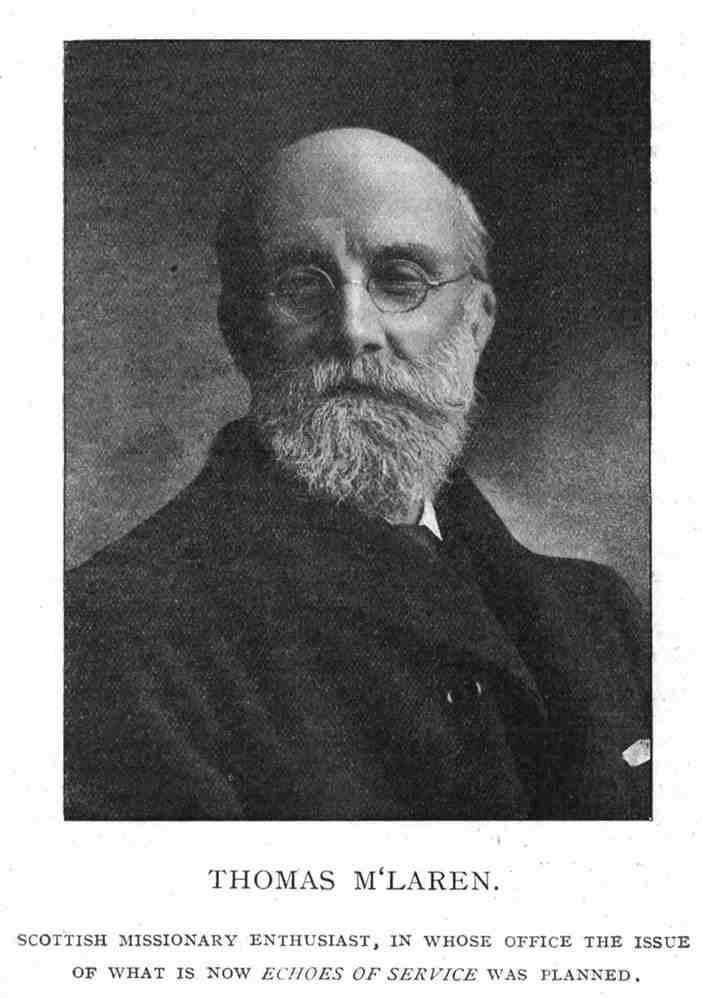
Thomas McLaren. Credit: Brethren Archive
John Morton & Rev David Miller
The house was empty in 1875. In 1877 John Morton was resident, but no details are forthcoming about him. In 1879 the occupier was the Rev David K Miller, minister of the Elgin St UP Church, but by 1880 the house was empty again and there was a new minister .
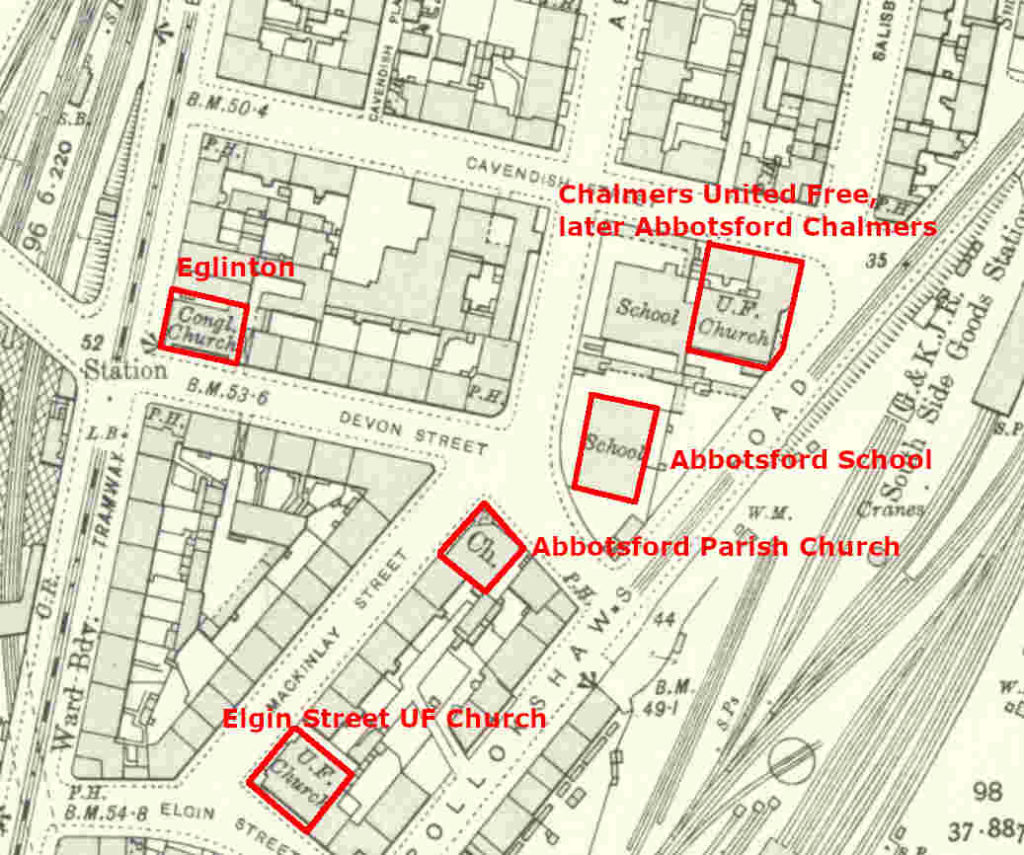
Devon Street area Churches c 1909. Elgin St is now Turriff St. Credit: NLS Maps

Elgin St UP Church after closure, 1973. Credit: Streapadair
A James Morton of 9 Queen Square was letting office space in Queens Chambers in July 1880.
Thomas Dodd

Thomas Dodd. Credit: Glasgowwestaddress.co.uk
Thomas Dodd was present from around 1880 to 1888, though a tenant of the owner, a John Webster (1885). Circa 1890 he moved to 16 Leslie Road. He was the Principal Surveyor to the Lloyds Register Of British & Foreign Shipping in Glasgow. He married Amelia Breaks in 1875, and had a family of seven; the first two born in Genoa, Italy and the rest in Glasgow. He retired to Seamill, West Kilbride, where he died in 1922.
The Index of Glasgow Men (1909) provides a fuller biography :
THE Principal Surveyor and Secretary of Lloyds’ Register of Shipping at Glasgow, is a son of Mr. Thomas Dodd, late Examiner of Contract Work for the Admiralty, who was well known by the shipbuilders on the Clyde from 1862 to 1890 in connection with the building of the first armour-clad men-of-war.
He was born in April, 1847, at Portsmouth, where he was brought up and received his education. Afterwards he passed a very good examination before the Civil Service Commissioners in 1861, ranking first of all the candidates presented, and he entered Portsmouth Dockyard as a shipwright apprentice. Having passed another good examination in the fifth year of his apprenticeship, he received from the Lords Commissioners of the Admiralty a scholarship for two years. During that time he underwent a superior course of training, being taught the principles of design, properties of vessels, etc., and was instructed in the actual work of laying off and ship construction. For his success at half-yearly examinations, which were conducted by the General Director of Education, he also received valuable prizes from the Lords Commissioners of the Admiralty in the years 1864, 1865, and 1867.
On the completion of the seven years he received his indentures, and was employed both in building and laying off wooden and iron ships. Then in December, 1868, he was appointed an assistant overseer of iron and composite vessels being built by contract for H.M. Service, In this capacity he was employed on the armour-clad frigates Swiftsure and Triumph {complete iron vessels sheathed with wood), on the turret ship Cyclops, on four iron gun vessels, and on the iron troopship Assistance, built for H.M. Service.
Mr. Dodd was contemporary with Sir Philip Watts, K.C.B., the present Chief Constructor of the Navy, who received the Admiralty Scholarship at Portsmouth at the same time.
He was appointed Surveyor to Lloyds’ Register of British and Foreign Shipping in May, 1873, and was employed in the London office, and as Surveyor at Leith and Sunderland until November, 1874. While in London, among other important work, he assisted the late Mr. Martell in the preparation of the first Freeboard Tables, which were ultimately, in 1890, accepted by the Government as the basis for assigning freeboards to vessels in the Mercantile Marine. In November, 1874, he was appointed exclusive Surveyor at Genoa, Italy, with charge of the office there, and he superintended, for classification in Lloyds’ Register, the construction of a very large number of the wooden vessels then built along the Mediterranean coast from Savona to Sestri Levante. At the same time, in addition to this duty, he held important surveys at Malta and Marseilles on vessels heavily damaged. In December, 1877, he was temporarily appointed to Marseilles for four or five months, after which he returned to London. and was employed partly in the office there and partly in surveying duties on the river Thames.
In June, 1878, he was again sent to Marseilles, where, for about six months, he fulfilled important special duties, and in February, 1880, he was promoted to his present post in Glasgow.
At the time of his coming north there were, in the Glasgow district, only eight Surveyors connected with Lloyds’ Register. Now there are thirty-one. In November, 1889, he was appointed Principal Surveyor for the Glasgow district, having acted in that position for about twelve months previously. When the Glasgow Committee of Lloyds’ Register of British and Foreign Shipping was formed in June, 1900, he was appointed its Secretary in addition to his principal surveyorship.
Mr. Dodd is well known by all the shipbuilders on the Clyde. During his twenty-seven years in Glasgow he has been more or less connected with all the improvements from time to time made in iron and steel shipbuilding, and he has superintended the construction of most of the large mercantile vessels built in the district during that time.
Mr. Dodd has been a Member of the Institution of Naval Architects since 1875, and is also a Member of the Institution of Engineers and Shipbuilders in Scotland.
Frederick Rowntree

Frederick Rowntree. Credit: Wikipedia
Frederick Rowntree (1860-1927) moved in around 1891, and appears in the 1891 census with his wife and young son Douglas (incorrectly as Rowantree, perhaps an accidental embellishment by a Scottish census taker). His second child Colin was born at Queen Square that August.
Fred was born in Scarborough, the son of John Rowntree, master grocer, and Ann Webster. The family were Quakers, and his great uncle was Joseph Rowntree, a grocer in York, whose son, also Joseph, became a great social reformer, and developed the famous Rowntree’s chocolate firm with his brother Henry.
Fred trained as an architect and initially worked in England, but in 1890 formed a partnership with Scottish architect Malcolm Stark in Glasgow. The reason for moving north is unclear, although he had family and quaker connections in Glasgow, and had married Mary Anna Gray at the Friends Meeting House in North Portland Street in Glasgow in 1886. Mary was from Pollokshields, daughter of William Gray, a biscuit manufacturer. The partnership was created to make a successful competition bid for the Govan District Asylum, better known in modern times as Leverndale Hospital, although now converted to housing.
Other works included some with family connections, such as extensions to William Gray’s biscuit factory in Kinning Town, and the central offices for Rowntree’s Cocoa Works in York, but in 1900 the partnership was dissolved. Stark had descended into alcoholism after health problems and a long succession of near misses in national competitions took their toll. They had only narrowly missed winning the commission for Belfast City Hall, but the Govan Asylum had remained their only significant success . Rowntree left Glasgow and relocated his practice to Hammersmith. He was possibly one of the first Quaker Architects, and was influenced by and closely associated with the Arts & Crafts Movement.

Leverndale Hospital, the former Govan District Asylum, by Stark & Rowntree. n.d. Credit: Aerofilms / Britain from the Air
Both Douglas and Colin became architects in his firm, which designed the West China University at Chengtu, Szechuan. Frederick died on 7 January 1927 after an operation .
Alex B McNair
Alexander McNair and his large family moved in around 1889-90, and were recorded in the 1891 census. His father was a dairyman in Renfrewshire, and at 16 he was working as a porter. He is subsequently recorded (perhaps inaccurately transcribed) as a carrier in 1891, a carver (as was his son Matthew) in the 1901 census, and more accurately a fish curer in Salkeld Street in 1901.
John George Ure
John was born in Blackwood, South Australia in 1858 to Glasgow-born farmer Robert and his wife Barbara Wark. Blackwood was a farming area north of Adelaide but the first land grants were only in the 1840s so they would have been pioneer farmers. John returned to Glasgow with his father after the death of his mother, and married Agnes Arbuckle. He started out as a civil and mining engineer, but was later listed as a shipping or mercantile clerk. He died in 1914, while his wife was still in Queen Square in 1915.
Samuel Grant
Samuel was resident 1920-1925 and worked for John Green & Co, masons and brickbuilders at 65 Nithsdale Street.
Rev J Cameron Peddie
Initially I had no further details on “C Peddie” in the Post Office Directories, but a reader, Pamela, turns out to be his grand-daughter and has identified him.
Rev John Cameron Peddie (1887 – 1968) was born in Forgue, Aberdeenshire, and studied at Abderdeen University before moving to Glasgow. He lived in the house from the early to mid 1930s till approx 1961, when he retired. He was Minister of Hutchesontown Parish Church in the Gorbals and became known in Glasgow as the ‘Gangster’s Friend’ – he worked long and hard at bringing the gangs of the time off the streets by setting up Boys’ Clubs. He was married, and had four children, James (who died an infant), Rosalind, Carol and Richard.
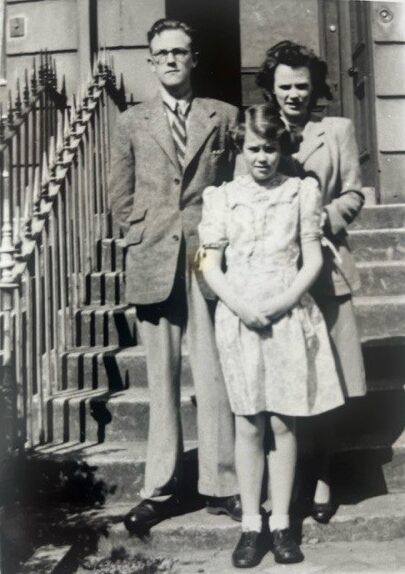
The Peddie children on the steps of 20 Queen Square, April 1950, on the occasion of Rosalind’s engagement. Richard & Rosalind, with Carol to the front. Source: Pamela Chantry
In 1935 he wrote a review of the book ‘No Mean City’ which was published in the Scottish Daily Express. Later in his Ministry, he started the Church of Scotland Healing Mission, which started with him praying for the power to heal by the laying on of hands. He set aside an hour every day to pray for this in his Sanctuary, which was located in the lower ground floor of the house. He wrote a book, The Forgotten Talent, about his healing mission, writing briefly about his work with the gangs to show that his head wasn’t lost in the clouds.
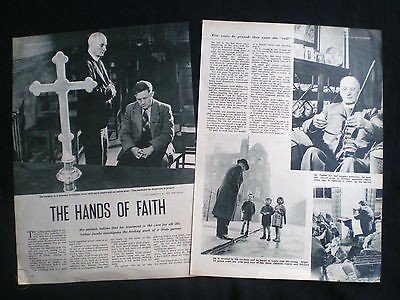
The Hands of Faith. Article about Rev Peddie’s healing mission, Dec 1955. Credit: Worthpoint
In his book he explained how a major cause of the gang problem was unemployment coupled with American gangster films that glamorised the violent and sometimes fatal lifestyle. Completely undaunted by their fearsome reputation, Peddie reasoned that “… if these lads would not come to church, it was the Church’s duty to go to them.” In the two years that followed, Peddie transformed the thirty gangs into thirty “Clubs” which gave the previous gang members a sense of purpose and fulfilment through work schemes such as a firewood factory and an advertising agency among others, all organised by Peddie. Thirty years later, Peddie stated that over seventy five percent of those former gang members went on to be decent, respectable citizens.
There is an account of such work in the story of James McClusky, a member of the South Side Stickers who was jailed at 16 for stabbing to death James Tait. On his release he wanted to go straight, but also intended to seek revenge on the man who betrayed him in court. He was surprised to be accepted into Peddie’s “South Side Stickers Club” with a welcome home concert party amongst his friends who had denounced violence, and Peddie managed to keep him on the straight and narrow . He also made the Scotsman in August 1930.

Reforming Gangsters. The Scotsman, August 1930. Credit: BNA
Peddie died on 14 January 1968 in Kilsyth, Dunbartonshire .
Hutchesontown Parish Church was situated on Old Rutherglen Road at Florence Street. It opened in 1900 replacing the previous church which had fallen victim to the widening of the railway bridge into St Enoch Station. It closed in 1967, and was subsequently demolished, but not before being captured on film by Streapadair. More details are available on Gerry Blaikie’s website .
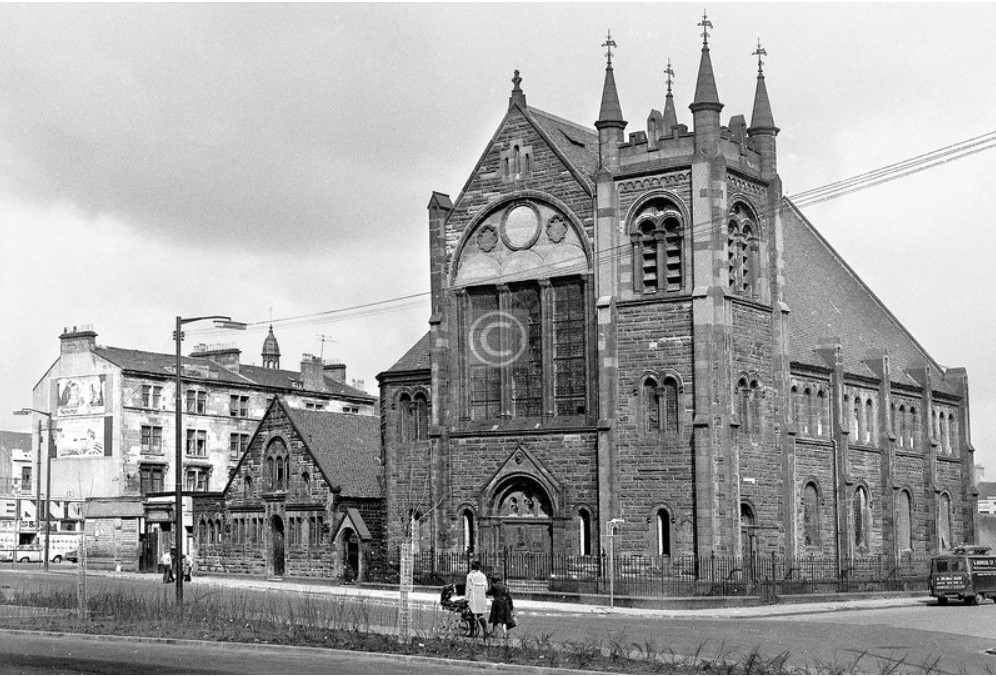
Hutcheson Parish Church after closure, April 1973. Credit: Streapadair
Pamela notes she used to be passed through the basement window (and other guests climbed through it) to save her ageing grandmother climbing the stairs to answer the front door. When the house was sold, she believes it was split into flats, then in the 1980’s a family bought it and converted it back into the one house. The daughter tracked her down when she came across some items that her parents had found when they removed a fireplace – a photograph and a letter to Santa written by her uncle.
Additions and corrections are welcome.
References
{3557955:B3VXJA2K};{3557955:PAMUJFL2},{3557955:BS274TZD};{3557955:TL8KIMUF};{3557955:SSQV6FTH};{3557955:CRNYR4H9},{3557955:HAUXHVEH};{3557955:Z8GHQKAQ};{3557955:AFLBQYDQ};{3557955:EKXA7DB6},{3557955:J8UEU3MY}
vancouver
asc
0
3324
%7B%22status%22%3A%22success%22%2C%22updateneeded%22%3Afalse%2C%22instance%22%3A%22zotpress-88792bd018332fcb4a4491ea14a9cf03%22%2C%22meta%22%3A%7B%22request_last%22%3A0%2C%22request_next%22%3A0%2C%22used_cache%22%3Atrue%7D%2C%22data%22%3A%5B%7B%22key%22%3A%22EKXA7DB6%22%2C%22library%22%3A%7B%22id%22%3A3557955%7D%2C%22meta%22%3A%7B%22numChildren%22%3A1%7D%2C%22bib%22%3A%22%3Cdiv%20class%3D%5C%22csl-bib-body%5C%22%20style%3D%5C%22line-height%3A%201.35%3B%20%5C%22%3E%5Cn%20%20%3Cdiv%20class%3D%5C%22csl-entry%5C%22%20style%3D%5C%22clear%3A%20left%3B%20%5C%22%3E%5Cn%20%20%20%20%3Cdiv%20class%3D%5C%22csl-left-margin%5C%22%20style%3D%5C%22float%3A%20left%3B%20padding-right%3A%200.5em%3B%20text-align%3A%20right%3B%20width%3A%201em%3B%5C%22%3E1.%3C%5C%2Fdiv%3E%3Cdiv%20class%3D%5C%22csl-right-inline%5C%22%20style%3D%5C%22margin%3A%200%20.4em%200%201.5em%3B%5C%22%3EHutchesontown%20Glasgow%2C%20Illustrated%20Guide%20%5BInternet%5D.%20%5Bcited%202022%20Feb%2025%5D.%20Available%20from%3A%20%3Ca%20href%3D%27http%3A%5C%2F%5C%2Fwww.gerryblaikie.com%5C%2Fgorbals%5C%2Fhutchesontown.htm%27%3Ehttp%3A%5C%2F%5C%2Fwww.gerryblaikie.com%5C%2Fgorbals%5C%2Fhutchesontown.htm%3C%5C%2Fa%3E%3C%5C%2Fdiv%3E%5Cn%20%20%3C%5C%2Fdiv%3E%5Cn%3C%5C%2Fdiv%3E%22%2C%22data%22%3A%7B%22itemType%22%3A%22webpage%22%2C%22title%22%3A%22Hutchesontown%20Glasgow%2C%20Illustrated%20Guide%22%2C%22creators%22%3A%5B%5D%2C%22abstractNote%22%3A%22%22%2C%22date%22%3A%22%22%2C%22url%22%3A%22http%3A%5C%2F%5C%2Fwww.gerryblaikie.com%5C%2Fgorbals%5C%2Fhutchesontown.htm%22%2C%22language%22%3A%22%22%2C%22collections%22%3A%5B%22CAR6MXPM%22%5D%2C%22dateModified%22%3A%222022-02-25T18%3A56%3A06Z%22%7D%7D%2C%7B%22key%22%3A%22J8UEU3MY%22%2C%22library%22%3A%7B%22id%22%3A3557955%7D%2C%22meta%22%3A%7B%22numChildren%22%3A1%7D%2C%22bib%22%3A%22%3Cdiv%20class%3D%5C%22csl-bib-body%5C%22%20style%3D%5C%22line-height%3A%201.35%3B%20%5C%22%3E%5Cn%20%20%3Cdiv%20class%3D%5C%22csl-entry%5C%22%20style%3D%5C%22clear%3A%20left%3B%20%5C%22%3E%5Cn%20%20%20%20%3Cdiv%20class%3D%5C%22csl-left-margin%5C%22%20style%3D%5C%22float%3A%20left%3B%20padding-right%3A%200.5em%3B%20text-align%3A%20right%3B%20width%3A%201em%3B%5C%22%3E1.%3C%5C%2Fdiv%3E%3Cdiv%20class%3D%5C%22csl-right-inline%5C%22%20style%3D%5C%22margin%3A%200%20.4em%200%201.5em%3B%5C%22%3Eurbanglasgow.co.uk%20%5BInternet%5D.%20%5Bcited%202022%20Feb%2025%5D.%20urbanglasgow.co.uk-Glasgow%20in%20the%201970s%20-%20Last%20days%20of%20the%20Old%20Gorbals%20Page%202.%20Available%20from%3A%20%3Ca%20href%3D%27https%3A%5C%2F%5C%2Furbanglasgow.co.uk%5C%2Fglasgow-in-the-1970s-last-days-of-the-old-gorbals-t1236-s10.html%27%3Ehttps%3A%5C%2F%5C%2Furbanglasgow.co.uk%5C%2Fglasgow-in-the-1970s-last-days-of-the-old-gorbals-t1236-s10.html%3C%5C%2Fa%3E%3C%5C%2Fdiv%3E%5Cn%20%20%3C%5C%2Fdiv%3E%5Cn%3C%5C%2Fdiv%3E%22%2C%22data%22%3A%7B%22itemType%22%3A%22webpage%22%2C%22title%22%3A%22urbanglasgow.co.uk-Glasgow%20in%20the%201970s%20-%20Last%20days%20of%20the%20Old%20Gorbals%20Page%202%22%2C%22creators%22%3A%5B%5D%2C%22abstractNote%22%3A%22Old%20Rutherglen%20Rd%2C%20looking%20west%20from%20Crown%20St.%20Some%20of%20Lennoxs%20prices%3A%20Margarine%206p%20%5C%2F%20Tea%20biscuits%203p%20%5C%2F%20Sugar%207p%20for%202lb%20%5C%2F%20Condensed%20milk%208p.%20%5Cu00a0April%22%2C%22date%22%3A%22%22%2C%22url%22%3A%22https%3A%5C%2F%5C%2Furbanglasgow.co.uk%5C%2Fglasgow-in-the-1970s-last-days-of-the-old-gorbals-t1236-s10.html%22%2C%22language%22%3A%22en-gb%22%2C%22collections%22%3A%5B%22CAR6MXPM%22%5D%2C%22dateModified%22%3A%222022-02-25T18%3A56%3A06Z%22%7D%7D%2C%7B%22key%22%3A%22Z8GHQKAQ%22%2C%22library%22%3A%7B%22id%22%3A3557955%7D%2C%22meta%22%3A%7B%22creatorSummary%22%3A%22Davies%22%2C%22parsedDate%22%3A%222013-08-15%22%2C%22numChildren%22%3A1%7D%2C%22bib%22%3A%22%3Cdiv%20class%3D%5C%22csl-bib-body%5C%22%20style%3D%5C%22line-height%3A%201.35%3B%20%5C%22%3E%5Cn%20%20%3Cdiv%20class%3D%5C%22csl-entry%5C%22%20style%3D%5C%22clear%3A%20left%3B%20%5C%22%3E%5Cn%20%20%20%20%3Cdiv%20class%3D%5C%22csl-left-margin%5C%22%20style%3D%5C%22float%3A%20left%3B%20padding-right%3A%200.5em%3B%20text-align%3A%20right%3B%20width%3A%201em%3B%5C%22%3E1.%3C%5C%2Fdiv%3E%3Cdiv%20class%3D%5C%22csl-right-inline%5C%22%20style%3D%5C%22margin%3A%200%20.4em%200%201.5em%3B%5C%22%3EDavies%20A.%20City%20of%20Gangs%3A%20Glasgow%20and%20the%20Rise%20of%20the%20British%20Gangster%20%5BInternet%5D.%20Hachette%20UK%3B%202013.%20447%20p.%20Available%20from%3A%20https%3A%5C%2F%5C%2Fbooks.google.co.uk%5C%2Fbooks%3Fid%3Dmn4Tn6qK2QkC%26amp%3Bpg%3DRA1-PT76%26amp%3Blpg%3DRA1-PT76%26amp%3Bdq%3Dthe%2Bgangster%2527s%2Bfriend%2Bpeddie%26amp%3Bsource%3Dbl%26amp%3Bots%3DV7heF_n0tw%26amp%3Bsig%3DACfU3U0WcuAz_imxP6hA3u-ICpHq-fzPWA%26amp%3Bhl%3Den%26amp%3Bsa%3DX%26amp%3Bved%3D2ahUKEwjn26SUwJv2AhWDgVwKHb45A40Q6AF6BAgzEAM%23v%3Donepage%26amp%3Bq%3Dthe%2520gangster%26%23x2019%3Bs%2520friend%2520peddie%26amp%3Bf%3Dfalse%3C%5C%2Fdiv%3E%5Cn%20%20%3C%5C%2Fdiv%3E%5Cn%3C%5C%2Fdiv%3E%22%2C%22data%22%3A%7B%22itemType%22%3A%22book%22%2C%22title%22%3A%22City%20of%20Gangs%3A%20Glasgow%20and%20the%20Rise%20of%20the%20British%20Gangster%22%2C%22creators%22%3A%5B%7B%22creatorType%22%3A%22author%22%2C%22firstName%22%3A%22Andrew%22%2C%22lastName%22%3A%22Davies%22%7D%5D%2C%22abstractNote%22%3A%22%22%2C%22date%22%3A%222013-08-15%22%2C%22language%22%3A%22en%22%2C%22ISBN%22%3A%22978-1-4447-3978-7%22%2C%22url%22%3A%22https%3A%5C%2F%5C%2Fbooks.google.co.uk%5C%2Fbooks%3Fid%3Dmn4Tn6qK2QkC%26pg%3DRA1-PT76%26lpg%3DRA1-PT76%26dq%3Dthe%2Bgangster%2527s%2Bfriend%2Bpeddie%26source%3Dbl%26ots%3DV7heF_n0tw%26sig%3DACfU3U0WcuAz_imxP6hA3u-ICpHq-fzPWA%26hl%3Den%26sa%3DX%26ved%3D2ahUKEwjn26SUwJv2AhWDgVwKHb45A40Q6AF6BAgzEAM%23v%3Donepage%26q%3Dthe%2520gangster%27s%2520friend%2520peddie%26f%3Dfalse%22%2C%22collections%22%3A%5B%22CAR6MXPM%22%5D%2C%22dateModified%22%3A%222022-02-25T18%3A49%3A13Z%22%7D%7D%2C%7B%22key%22%3A%22AFLBQYDQ%22%2C%22library%22%3A%7B%22id%22%3A3557955%7D%2C%22meta%22%3A%7B%22numChildren%22%3A1%7D%2C%22bib%22%3A%22%3Cdiv%20class%3D%5C%22csl-bib-body%5C%22%20style%3D%5C%22line-height%3A%201.35%3B%20%5C%22%3E%5Cn%20%20%3Cdiv%20class%3D%5C%22csl-entry%5C%22%20style%3D%5C%22clear%3A%20left%3B%20%5C%22%3E%5Cn%20%20%20%20%3Cdiv%20class%3D%5C%22csl-left-margin%5C%22%20style%3D%5C%22float%3A%20left%3B%20padding-right%3A%200.5em%3B%20text-align%3A%20right%3B%20width%3A%201em%3B%5C%22%3E1.%3C%5C%2Fdiv%3E%3Cdiv%20class%3D%5C%22csl-right-inline%5C%22%20style%3D%5C%22margin%3A%200%20.4em%200%201.5em%3B%5C%22%3EJohn%20Cameron%20Peddie%20-%20Wikipedia%20%5BInternet%5D.%20%5Bcited%202022%20Feb%2025%5D.%20Available%20from%3A%20%3Ca%20href%3D%27https%3A%5C%2F%5C%2Fen.wikipedia.org%5C%2Fwiki%5C%2FJohn_Cameron_Peddie%27%3Ehttps%3A%5C%2F%5C%2Fen.wikipedia.org%5C%2Fwiki%5C%2FJohn_Cameron_Peddie%3C%5C%2Fa%3E%3C%5C%2Fdiv%3E%5Cn%20%20%3C%5C%2Fdiv%3E%5Cn%3C%5C%2Fdiv%3E%22%2C%22data%22%3A%7B%22itemType%22%3A%22webpage%22%2C%22title%22%3A%22John%20Cameron%20Peddie%20-%20Wikipedia%22%2C%22creators%22%3A%5B%5D%2C%22abstractNote%22%3A%22%22%2C%22date%22%3A%22%22%2C%22url%22%3A%22https%3A%5C%2F%5C%2Fen.wikipedia.org%5C%2Fwiki%5C%2FJohn_Cameron_Peddie%22%2C%22language%22%3A%22%22%2C%22collections%22%3A%5B%22CAR6MXPM%22%5D%2C%22dateModified%22%3A%222022-02-25T18%3A37%3A33Z%22%7D%7D%2C%7B%22key%22%3A%22B3VXJA2K%22%2C%22library%22%3A%7B%22id%22%3A3557955%7D%2C%22meta%22%3A%7B%22numChildren%22%3A1%7D%2C%22bib%22%3A%22%3Cdiv%20class%3D%5C%22csl-bib-body%5C%22%20style%3D%5C%22line-height%3A%201.35%3B%20%5C%22%3E%5Cn%20%20%3Cdiv%20class%3D%5C%22csl-entry%5C%22%20style%3D%5C%22clear%3A%20left%3B%20%5C%22%3E%5Cn%20%20%20%20%3Cdiv%20class%3D%5C%22csl-left-margin%5C%22%20style%3D%5C%22float%3A%20left%3B%20padding-right%3A%200.5em%3B%20text-align%3A%20right%3B%20width%3A%201em%3B%5C%22%3E1.%3C%5C%2Fdiv%3E%3Cdiv%20class%3D%5C%22csl-right-inline%5C%22%20style%3D%5C%22margin%3A%200%20.4em%200%201.5em%3B%5C%22%3EThomas%20McLaren%20%7C%20Plymouth%20Brethren%20Archive%20%5BInternet%5D.%20%5Bcited%202022%20Feb%2025%5D.%20Available%20from%3A%20%3Ca%20href%3D%27https%3A%5C%2F%5C%2Fwww.brethrenarchive.org%5C%2Fpeople%5C%2Fthomas-mclaren%5C%2F%27%3Ehttps%3A%5C%2F%5C%2Fwww.brethrenarchive.org%5C%2Fpeople%5C%2Fthomas-mclaren%5C%2F%3C%5C%2Fa%3E%3C%5C%2Fdiv%3E%5Cn%20%20%3C%5C%2Fdiv%3E%5Cn%3C%5C%2Fdiv%3E%22%2C%22data%22%3A%7B%22itemType%22%3A%22webpage%22%2C%22title%22%3A%22Thomas%20McLaren%20%7C%20Plymouth%20Brethren%20Archive%22%2C%22creators%22%3A%5B%5D%2C%22abstractNote%22%3A%22%22%2C%22date%22%3A%22%22%2C%22url%22%3A%22https%3A%5C%2F%5C%2Fwww.brethrenarchive.org%5C%2Fpeople%5C%2Fthomas-mclaren%5C%2F%22%2C%22language%22%3A%22%22%2C%22collections%22%3A%5B%22CAR6MXPM%22%5D%2C%22dateModified%22%3A%222022-02-25T11%3A34%3A43Z%22%7D%7D%2C%7B%22key%22%3A%22SSQV6FTH%22%2C%22library%22%3A%7B%22id%22%3A3557955%7D%2C%22meta%22%3A%7B%22numChildren%22%3A1%7D%2C%22bib%22%3A%22%3Cdiv%20class%3D%5C%22csl-bib-body%5C%22%20style%3D%5C%22line-height%3A%201.35%3B%20%5C%22%3E%5Cn%20%20%3Cdiv%20class%3D%5C%22csl-entry%5C%22%20style%3D%5C%22clear%3A%20left%3B%20%5C%22%3E%5Cn%20%20%20%20%3Cdiv%20class%3D%5C%22csl-left-margin%5C%22%20style%3D%5C%22float%3A%20left%3B%20padding-right%3A%200.5em%3B%20text-align%3A%20right%3B%20width%3A%201em%3B%5C%22%3E1.%3C%5C%2Fdiv%3E%3Cdiv%20class%3D%5C%22csl-right-inline%5C%22%20style%3D%5C%22margin%3A%200%20.4em%200%201.5em%3B%5C%22%3ESAR013740%20SCOTLAND.%20Leverndale%20Hospital%2C%20510%20Crookston%20Road%20Lochwinnoch%2C%20Renfrewshire%2C%20Scotland.%20An%20oblique%20aerial%20photograph%20taken%20facing%20North%5C%2FWest.%20%7C%20Britain%20From%20Above%20%5BInternet%5D.%20%5Bcited%202022%20Feb%2023%5D.%20Available%20from%3A%20%3Ca%20href%3D%27https%3A%5C%2F%5C%2Fwww.britainfromabove.org.uk%5C%2Fen%5C%2Fimage%5C%2FSAR013740%27%3Ehttps%3A%5C%2F%5C%2Fwww.britainfromabove.org.uk%5C%2Fen%5C%2Fimage%5C%2FSAR013740%3C%5C%2Fa%3E%3C%5C%2Fdiv%3E%5Cn%20%20%3C%5C%2Fdiv%3E%5Cn%3C%5C%2Fdiv%3E%22%2C%22data%22%3A%7B%22itemType%22%3A%22webpage%22%2C%22title%22%3A%22SAR013740%20SCOTLAND.%20Leverndale%20Hospital%2C%20510%20Crookston%20Road%20Lochwinnoch%2C%20Renfrewshire%2C%20Scotland.%20An%20oblique%20aerial%20photograph%20taken%20facing%20North%5C%2FWest.%20%7C%20Britain%20From%20Above%22%2C%22creators%22%3A%5B%5D%2C%22abstractNote%22%3A%22%22%2C%22date%22%3A%22%22%2C%22url%22%3A%22https%3A%5C%2F%5C%2Fwww.britainfromabove.org.uk%5C%2Fen%5C%2Fimage%5C%2FSAR013740%22%2C%22language%22%3A%22%22%2C%22collections%22%3A%5B%22CAR6MXPM%22%5D%2C%22dateModified%22%3A%222022-02-23T00%3A08%3A27Z%22%7D%7D%2C%7B%22key%22%3A%22CRNYR4H9%22%2C%22library%22%3A%7B%22id%22%3A3557955%7D%2C%22meta%22%3A%7B%22numChildren%22%3A1%7D%2C%22bib%22%3A%22%3Cdiv%20class%3D%5C%22csl-bib-body%5C%22%20style%3D%5C%22line-height%3A%201.35%3B%20%5C%22%3E%5Cn%20%20%3Cdiv%20class%3D%5C%22csl-entry%5C%22%20style%3D%5C%22clear%3A%20left%3B%20%5C%22%3E%5Cn%20%20%20%20%3Cdiv%20class%3D%5C%22csl-left-margin%5C%22%20style%3D%5C%22float%3A%20left%3B%20padding-right%3A%200.5em%3B%20text-align%3A%20right%3B%20width%3A%201em%3B%5C%22%3E1.%3C%5C%2Fdiv%3E%3Cdiv%20class%3D%5C%22csl-right-inline%5C%22%20style%3D%5C%22margin%3A%200%20.4em%200%201.5em%3B%5C%22%3EFred%20Rowntree%20%281860-1927%29%20%5BInternet%5D.%20The%20Rowntree%20Society.%20%5Bcited%202022%20Feb%2020%5D.%20Available%20from%3A%20%3Ca%20href%3D%27https%3A%5C%2F%5C%2Fwww.rowntreesociety.org.uk%5C%2Fexplore-rowntree-history%5C%2Frowntree-a-z%5C%2Ffred-rowntree-1860-1927%5C%2F%27%3Ehttps%3A%5C%2F%5C%2Fwww.rowntreesociety.org.uk%5C%2Fexplore-rowntree-history%5C%2Frowntree-a-z%5C%2Ffred-rowntree-1860-1927%5C%2F%3C%5C%2Fa%3E%3C%5C%2Fdiv%3E%5Cn%20%20%3C%5C%2Fdiv%3E%5Cn%3C%5C%2Fdiv%3E%22%2C%22data%22%3A%7B%22itemType%22%3A%22blogPost%22%2C%22title%22%3A%22Fred%20Rowntree%20%281860-1927%29%22%2C%22creators%22%3A%5B%5D%2C%22abstractNote%22%3A%22Architect.%20One%20of%20the%20%5Cu2018Scarborough%20Rowntrees%5Cu2019%2C%20he%20was%20a%20second%20cousin%20to%5Cu00a0Seebohm%20Rowntree%5Cu00a0and%20the%20fourth%20child%20of%20John%20Rowntree%2C%20a%20Scarborough%20grocer%20and%20draper%2C%20and%20Ann%20Webster.%20In%201876%20he%20was%20articled%20with%20C%20A%20Bury%20in%20Scarborough.%20He%20was%20perhaps%20one%20of%20the%20first%20Quaker%20Architects%2C%20and%20was%20influenced%20by%20and%20closely%20associated%20with%20%5B%5Cu2026%5D%22%2C%22blogTitle%22%3A%22The%20Rowntree%20Society%22%2C%22date%22%3A%22%22%2C%22url%22%3A%22https%3A%5C%2F%5C%2Fwww.rowntreesociety.org.uk%5C%2Fexplore-rowntree-history%5C%2Frowntree-a-z%5C%2Ffred-rowntree-1860-1927%5C%2F%22%2C%22language%22%3A%22en%22%2C%22collections%22%3A%5B%22CAR6MXPM%22%5D%2C%22dateModified%22%3A%222022-02-20T21%3A37%3A11Z%22%7D%7D%2C%7B%22key%22%3A%22HAUXHVEH%22%2C%22library%22%3A%7B%22id%22%3A3557955%7D%2C%22meta%22%3A%7B%22numChildren%22%3A1%7D%2C%22bib%22%3A%22%3Cdiv%20class%3D%5C%22csl-bib-body%5C%22%20style%3D%5C%22line-height%3A%201.35%3B%20%5C%22%3E%5Cn%20%20%3Cdiv%20class%3D%5C%22csl-entry%5C%22%20style%3D%5C%22clear%3A%20left%3B%20%5C%22%3E%5Cn%20%20%20%20%3Cdiv%20class%3D%5C%22csl-left-margin%5C%22%20style%3D%5C%22float%3A%20left%3B%20padding-right%3A%200.5em%3B%20text-align%3A%20right%3B%20width%3A%201em%3B%5C%22%3E1.%3C%5C%2Fdiv%3E%3Cdiv%20class%3D%5C%22csl-right-inline%5C%22%20style%3D%5C%22margin%3A%200%20.4em%200%201.5em%3B%5C%22%3EDictionary%20of%20Scottish%20Architects%20-%20Fred%20Rowntree%20%5BInternet%5D.%20%5Bcited%202022%20Feb%2020%5D.%20Available%20from%3A%20%3Ca%20href%3D%27http%3A%5C%2F%5C%2Fwww.scottisharchitects.org.uk%5C%2Farchitect_full.php%3Fid%3D200959%27%3Ehttp%3A%5C%2F%5C%2Fwww.scottisharchitects.org.uk%5C%2Farchitect_full.php%3Fid%3D200959%3C%5C%2Fa%3E%3C%5C%2Fdiv%3E%5Cn%20%20%3C%5C%2Fdiv%3E%5Cn%3C%5C%2Fdiv%3E%22%2C%22data%22%3A%7B%22itemType%22%3A%22webpage%22%2C%22title%22%3A%22Dictionary%20of%20Scottish%20Architects%20-%20Fred%20Rowntree%22%2C%22creators%22%3A%5B%5D%2C%22abstractNote%22%3A%22%22%2C%22date%22%3A%22%22%2C%22url%22%3A%22http%3A%5C%2F%5C%2Fwww.scottisharchitects.org.uk%5C%2Farchitect_full.php%3Fid%3D200959%22%2C%22language%22%3A%22%22%2C%22collections%22%3A%5B%22CAR6MXPM%22%5D%2C%22dateModified%22%3A%222022-02-20T21%3A28%3A08Z%22%7D%7D%2C%7B%22key%22%3A%22PAMUJFL2%22%2C%22library%22%3A%7B%22id%22%3A3557955%7D%2C%22meta%22%3A%7B%22numChildren%22%3A1%7D%2C%22bib%22%3A%22%3Cdiv%20class%3D%5C%22csl-bib-body%5C%22%20style%3D%5C%22line-height%3A%201.35%3B%20%5C%22%3E%5Cn%20%20%3Cdiv%20class%3D%5C%22csl-entry%5C%22%20style%3D%5C%22clear%3A%20left%3B%20%5C%22%3E%5Cn%20%20%20%20%3Cdiv%20class%3D%5C%22csl-left-margin%5C%22%20style%3D%5C%22float%3A%20left%3B%20padding-right%3A%200.5em%3B%20text-align%3A%20right%3B%20width%3A%201em%3B%5C%22%3E1.%3C%5C%2Fdiv%3E%3Cdiv%20class%3D%5C%22csl-right-inline%5C%22%20style%3D%5C%22margin%3A%200%20.4em%200%201.5em%3B%5C%22%3ETheGlasgowStory%3A%20Elgin%20Street%20UP%20Church%20%5BInternet%5D.%20%5Bcited%202022%20Feb%2020%5D.%20Available%20from%3A%20%3Ca%20href%3D%27https%3A%5C%2F%5C%2Fwww.theglasgowstory.com%5C%2Fimage%5C%2F%3Finum%3DTGSD00528%27%3Ehttps%3A%5C%2F%5C%2Fwww.theglasgowstory.com%5C%2Fimage%5C%2F%3Finum%3DTGSD00528%3C%5C%2Fa%3E%3C%5C%2Fdiv%3E%5Cn%20%20%3C%5C%2Fdiv%3E%5Cn%3C%5C%2Fdiv%3E%22%2C%22data%22%3A%7B%22itemType%22%3A%22webpage%22%2C%22title%22%3A%22TheGlasgowStory%3A%20Elgin%20Street%20UP%20Church%22%2C%22creators%22%3A%5B%5D%2C%22abstractNote%22%3A%22%22%2C%22date%22%3A%22%22%2C%22url%22%3A%22https%3A%5C%2F%5C%2Fwww.theglasgowstory.com%5C%2Fimage%5C%2F%3Finum%3DTGSD00528%22%2C%22language%22%3A%22%22%2C%22collections%22%3A%5B%22CAR6MXPM%22%5D%2C%22dateModified%22%3A%222022-02-20T21%3A03%3A12Z%22%7D%7D%2C%7B%22key%22%3A%22TL8KIMUF%22%2C%22library%22%3A%7B%22id%22%3A3557955%7D%2C%22meta%22%3A%7B%22numChildren%22%3A1%7D%2C%22bib%22%3A%22%3Cdiv%20class%3D%5C%22csl-bib-body%5C%22%20style%3D%5C%22line-height%3A%201.35%3B%20%5C%22%3E%5Cn%20%20%3Cdiv%20class%3D%5C%22csl-entry%5C%22%20style%3D%5C%22clear%3A%20left%3B%20%5C%22%3E%5Cn%20%20%20%20%3Cdiv%20class%3D%5C%22csl-left-margin%5C%22%20style%3D%5C%22float%3A%20left%3B%20padding-right%3A%200.5em%3B%20text-align%3A%20right%3B%20width%3A%201em%3B%5C%22%3E1.%3C%5C%2Fdiv%3E%3Cdiv%20class%3D%5C%22csl-right-inline%5C%22%20style%3D%5C%22margin%3A%200%20.4em%200%201.5em%3B%5C%22%3EThomas%20James%20Dodd%20%5BInternet%5D.%20%5Bcited%202022%20Feb%2020%5D.%20Available%20from%3A%20%3Ca%20href%3D%27http%3A%5C%2F%5C%2Fwww.glasgowwestaddress.co.uk%5C%2F1909_Glasgow_Men%5C%2FDodd_Thomas_James.htm%27%3Ehttp%3A%5C%2F%5C%2Fwww.glasgowwestaddress.co.uk%5C%2F1909_Glasgow_Men%5C%2FDodd_Thomas_James.htm%3C%5C%2Fa%3E%3C%5C%2Fdiv%3E%5Cn%20%20%3C%5C%2Fdiv%3E%5Cn%3C%5C%2Fdiv%3E%22%2C%22data%22%3A%7B%22itemType%22%3A%22webpage%22%2C%22title%22%3A%22Thomas%20James%20Dodd%22%2C%22creators%22%3A%5B%5D%2C%22abstractNote%22%3A%22%22%2C%22date%22%3A%22%22%2C%22url%22%3A%22http%3A%5C%2F%5C%2Fwww.glasgowwestaddress.co.uk%5C%2F1909_Glasgow_Men%5C%2FDodd_Thomas_James.htm%22%2C%22language%22%3A%22%22%2C%22collections%22%3A%5B%22CAR6MXPM%22%5D%2C%22dateModified%22%3A%222022-02-20T17%3A04%3A07Z%22%7D%7D%2C%7B%22key%22%3A%22BS274TZD%22%2C%22library%22%3A%7B%22id%22%3A3557955%7D%2C%22meta%22%3A%7B%22numChildren%22%3A0%7D%2C%22bib%22%3A%22%3Cdiv%20class%3D%5C%22csl-bib-body%5C%22%20style%3D%5C%22line-height%3A%201.35%3B%20%5C%22%3E%5Cn%20%20%3Cdiv%20class%3D%5C%22csl-entry%5C%22%20style%3D%5C%22clear%3A%20left%3B%20%5C%22%3E%5Cn%20%20%20%20%3Cdiv%20class%3D%5C%22csl-left-margin%5C%22%20style%3D%5C%22float%3A%20left%3B%20padding-right%3A%200.5em%3B%20text-align%3A%20right%3B%20width%3A%201em%3B%5C%22%3E1.%3C%5C%2Fdiv%3E%3Cdiv%20class%3D%5C%22csl-right-inline%5C%22%20style%3D%5C%22margin%3A%200%20.4em%200%201.5em%3B%5C%22%3Eurbanglasgow.co.uk%20%5BInternet%5D.%20%5Bcited%202022%20Jan%2016%5D.%20Urban%20Glasgow-Glasgow%20in%20the%201970s%20-%20Last%20days%20of%20the%20Old%20Gorbals%20p7.%20Available%20from%3A%20%3Ca%20href%3D%27https%3A%5C%2F%5C%2Furbanglasgow.co.uk%5C%2Fglasgow-in-the-1970s-last-days-of-the-old-gorbals-t1236-s60.html%27%3Ehttps%3A%5C%2F%5C%2Furbanglasgow.co.uk%5C%2Fglasgow-in-the-1970s-last-days-of-the-old-gorbals-t1236-s60.html%3C%5C%2Fa%3E%3C%5C%2Fdiv%3E%5Cn%20%20%3C%5C%2Fdiv%3E%5Cn%3C%5C%2Fdiv%3E%22%2C%22data%22%3A%7B%22itemType%22%3A%22webpage%22%2C%22title%22%3A%22Urban%20Glasgow-Glasgow%20in%20the%201970s%20-%20Last%20days%20of%20the%20Old%20Gorbals%20p7%22%2C%22creators%22%3A%5B%5D%2C%22abstractNote%22%3A%22Eglinton%20Street%22%2C%22date%22%3A%22%22%2C%22url%22%3A%22https%3A%5C%2F%5C%2Furbanglasgow.co.uk%5C%2Fglasgow-in-the-1970s-last-days-of-the-old-gorbals-t1236-s60.html%22%2C%22language%22%3A%22en-gb%22%2C%22collections%22%3A%5B%22CAR6MXPM%22%5D%2C%22dateModified%22%3A%222022-01-16T20%3A49%3A48Z%22%7D%7D%5D%7D
1.
Davies A. City of Gangs: Glasgow and the Rise of the British Gangster [Internet]. Hachette UK; 2013. 447 p. Available from: https://books.google.co.uk/books?id=mn4Tn6qK2QkC&pg=RA1-PT76&lpg=RA1-PT76&dq=the+gangster%27s+friend+peddie&source=bl&ots=V7heF_n0tw&sig=ACfU3U0WcuAz_imxP6hA3u-ICpHq-fzPWA&hl=en&sa=X&ved=2ahUKEwjn26SUwJv2AhWDgVwKHb45A40Q6AF6BAgzEAM#v=onepage&q=the%20gangster’s%20friend%20peddie&f=false
1.
SAR013740 SCOTLAND. Leverndale Hospital, 510 Crookston Road Lochwinnoch, Renfrewshire, Scotland. An oblique aerial photograph taken facing North/West. | Britain From Above [Internet]. [cited 2022 Feb 23]. Available from:
https://www.britainfromabove.org.uk/en/image/SAR013740
Like this:
Like Loading...



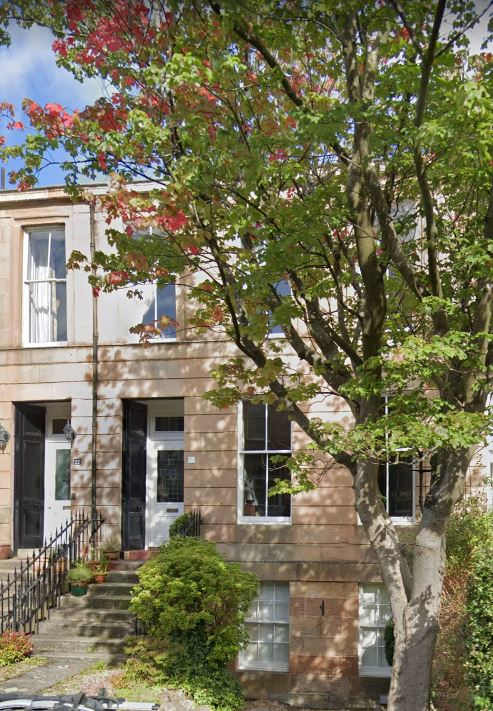









February 25, 2022 at 5:10 pm
I was fascinated to see this history of 20 Queen Square. My grandfather was Rev John Cameron Peddie who lived in the house from the early to mid 1930s till approx 1961, when he retired – I visited many times as a young child. He was Minister of Hutcheson Town Parish Church in the Gorbals and became known in Glasgow as the ‘Gangster’s Friend’ – he worked long and hard at bringing the gangs of the time off the streets by setting up Boy’s Clubs. In 1935 he wrote a review of the book ‘No Mean City’ which was published in the Scottish Daily Express ( I have a reprint of the article). Later in his Ministry, he started the Church of Scotland Healing Mission, which started with him praying for the power to heal by the laying on of hands. He set aside an hour every day to pray for this in his Sanctuary, which was located in the lower ground floor of the house. He wrote a book, The Forgotten Talent, about his healing mission, writing briefly about his work with the gangs to show that his head wasn’t lost in the clouds. I could give much more information about his life and his family, including my mother, of course, should you wish.
May 24, 2025 at 8:04 pm
Good afternoon Pamela,
My name is Lana Peddie from Ontario, Canada i am daughter of John William Peddie, who is the son of James Forbes Peddie (Huntly Scotland). My father talked about your Grandfather, my dad had one of his books now i have it. He said they were related (uncle or great uncle). I am trying to decipher the names in his marriage registration, I can see Mary Peddie wife of ??? Can you help. Would love to find out if Dad was related to your Grandfather. Thanks in advance
March 20, 2023 at 9:54 pm
It was interesting to read this story. Born in 1948, I was baptised by Mr.Peddie as my Mum and Dad were members here and my two sisters and I attended the Sunday School, the Girls’ Guildry and The Life Boys (36th). I can vaguely remember your Mum, Carol and she had a big high pram. I wonder if that was you in it. I would be delighted to hear from you. All the best. Jim Mack
April 30, 2023 at 8:38 am
It’s lovely to come across people who remember my family, however vaguely. I seem to remember my mother was involved in the Life Boys.
We share the fact of being baptised by my grandfather!
Re the pram, it depends when it was – Carol and her husband lived at 20 Queen Square when they were first married. Their eldest, Trish, was born in 1960. If it was mid 50s it would me, early 50s it would have been my sister, another Rosalind.
Thanks for posting!
Best wishes, Pamela